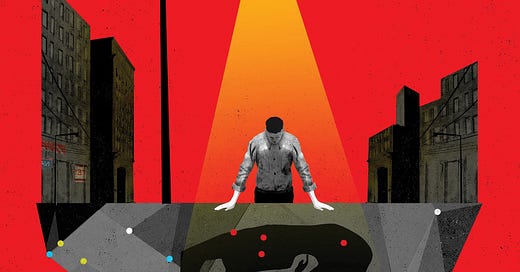Donohue, Levitt, Roe, and Wade: T-minus 20 years to a massive crime wave?
An academic grudge match two decades in the making.
Roe V. Wade has been overturned, and abortion is en route to handcuffs in 26 states. Social scientists, rejoice!
Wait, what? Why would any social scientist in their right mind want to celebrate a degradation of human rights? Oh, that’s right-the field has been arguing for decades about whether legal abortion was responsible for the late 20th century’s plummeting crime rates. This has been a knock-down drag out fight. Seriously, I ran out of words to link articles in that sentence. The Paper that started it all, Donohue and Levitt, 2000, has 788 citations.
D&L 2000 sparked a fight in the research community that continues to this day. However, I bet no one thought they would get to test falsifiability on Donohue-Levitt, hence why I say it’s time for social scientists to celebrate. I guess that’s one small perk to an entire society sliding back into the mud. In just a few short decades we’ll be able to put this problem to bed by looking at resultant crime rates in states that made abortion illegal again, or by, y’know, getting stabbed walking to our car.
Call me a toxic optimist for looking at the bright side of what is probably the largest mass-repeal of civil rights since the 1979 Iranian Revolution, but how often do you get to see the resolution of one of the most satisfying academic slug-fests of the past 20 years? It’s like getting front-row seats to Ali v. Frazier round 4. Now of course, it will take another 20 years to settle the fight, but we’ll start to see early results in 13-15, so fingers crossed that Donohue and Levitt were wrong! Heck, maybe we’ll get lucky and Lott and Whitley’s ridiculous proposal that legal abortion increases murder rate will turn out to be true, and in 20 years they’ll be no murders at all!
No one holds a grudge like an academic
The so-named Donohue-Levitt hypothesis goes like this: children who are unwanted or unsupported are more likely to turn to crime; legal abortion reduces the population of unwanted children. D&L argue their point using census and crime data (total arrests, rather than arrests per capita- which has been a major point of rebuttal).
This wasn’t a new idea, apparently the 1972 Rockefeller commission on “Population and the American Future” cited a 1966 study linking refused abortion to crime, which showed increased criminality in the 120 children whose mothers decided not to go through with the procedure. D&L used similar longitudinal methods to look at the decreasing criminality of age cohorts as time moved on from Roe V. Wade.
Many of Donohue and Levitt’s early critics cried foul while pointing to The Easterlin Effect, a hypothesis that size of birth cohort has a direct effect on crime rate. However, as is often the case in the social sciences, Easterlin itself is the subject of some controversy and has solid research contradicting it. Others still pointed at unmeasured period effects like drug use, and even other supporters of the abortion-crime linkage disagreed with D&L’s proposed ‘unwanted child’ mechanism.
Critics Foote and Goetz pointed out missing controls in D&L's regression model in the original 2000 paper, which was refuted by D&L, and then again counter-refuted by F&G (I’ve never seen an abstract start with “First off, you fucked up your computer model”). Donohue and Levitt have also oft refuted the attacks of their biggest critic, Ted Joyce, who came out of the gate swinging in 2004 with the lofty assertion that it was all just crack cocaine, and has since published four more rebuttals. Like my grandpa used to say, no one holds a grudge like an academic.
Donohue & Levitt are still carrying the flag. In 20202 they published a 20 year retrospective on their 2000 study finding that their prediction had been spot on the money:
We estimate that overall crime fell 17.5% from 1998 to 2014 due to legalized abortion— a decline of 1% per year.
Now of course this has a little bit of the Obama-giving-Obama-a-medal.jpg vibe to it, but they’ve received consistent support for the abortion-crime-link. Including multiple studies from across the pond, and via proposed selection effects. Reyes even calls out that her findings support D&L in her seminal 2007 leaded gasoline paper.
There’s also some silver lining to the debate: all of this fighting led to some other curious studies, such as questioning whether abortion legalization increases pet ownership, arguing that abortion legalization reduced STI incidence, and that legal abortion improved wage equality.
Really, social scientists should be thanking the Supreme Court for offering them such ample opportunity to resolve one of the greatest academic conflicts of our age. Unless of course they care more about bodily autonomy than statistically significant effects on national crime rate, in which case, continue to be outraged.
Conclusion
What does this all mean? Well, that social sciences are a rat’s nest and it’s very easy to support and refute arguments by selectively presenting data. The only way to find out for sure is to see whether or not getting rid of abortion increases crime, which we’ve unfortunately been doomed to do. If we’re lucky, all of the critics are right and the Donohue-Levitt hypothesis was spurious. I, for one, wish we didn’t have to find out.






If the social values you want to engineer don't include a notion that "communities should be able to live according to their own moral codes," you might want to reconsider that.
I personally want abortion, legalized, but find the reaction to the repeal of roe v. wade ruling symptomatic of why America needs serious change. Abortion is obviously an incredibly thorny issue, and pretending that there's only one solution right for everyone in the entire world, and that the _only_ response here is anger, is ignoring both the thorny question of when exactly a fetus becomes a human and gains rights, and what, exactly, the constitution should mean, if anything.
Pretending that this incredibly complex topic is simple and that all right-thinking people will reach the same conclusion is just asking for trouble.
Since 1973, there have been 60 million abortions in the US... a number equivalent to the current population of the nation of Italy.